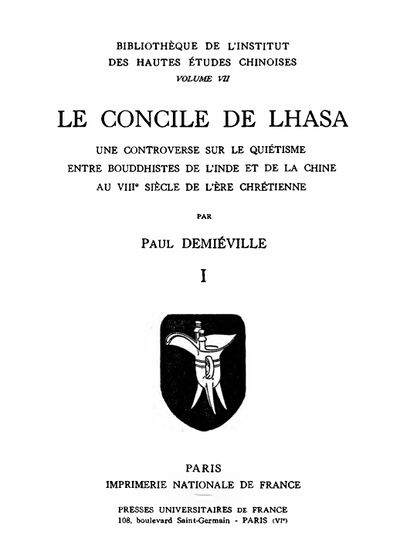No edit summary |
No edit summary |
||
| (2 intermediate revisions by the same user not shown) | |||
| Line 35: | Line 35: | ||
*{{i|Appendice. — FRAGMENTS DU DOSSIER INDIEN DE LA CONTROVERSE|333}} | *{{i|Appendice. — FRAGMENTS DU DOSSIER INDIEN DE LA CONTROVERSE|333}} | ||
**{{i|I. Le premier ''Bhāvanā-krama'' de Kamalaśīla, analyse sommaire d’après la version chinoise|333}} | **{{i|I. Le premier ''Bhāvanā-krama'' de Kamalaśīla, analyse sommaire d’après<br> la version chinoise|333}} | ||
**{{i|II. Le troisième ''Bhāvanā-krama'' de Kamalaśīla, traduction de la version tibétaine par M. Étienne Lamotte|336}} | **{{i|II. Le troisième ''Bhāvanā-krama'' de Kamalaśīla, traduction de la version<br> tibétaine par M. Étienne Lamotte|336}} | ||
*{{i|Addenda et Corrigenda|355}} | *{{i|Addenda et Corrigenda|355}} | ||
| Line 42: | Line 42: | ||
*{{i|Table des Matières|399}} | *{{i|Table des Matières|399}} | ||
*{{i|Texte du dossier chinois de la controverse|PL. I-XXXII}} | *{{i|Texte du dossier chinois de la controverse|PL. I-XXXII}} | ||
|StopPersonRedirects=No | |||
|AddRelatedTab=No | |AddRelatedTab=No | ||
}} | }} | ||
Latest revision as of 15:52, 26 June 2023
The following is from a review by Johannes Rahder in Philosophy East and West 4, no. 1 (1954): 87.
This excellent work, throwing a new light on the contacts between Indian and Chinese philosophers and theologians at the court of the Tibetan king, at the peak of his power in the middle of the eighth century, contains the following chapters: l) Translation of the Chinese record of the debate between the representative of the Chinese Buddhist philosophers, a Chinese Ch'an (Zen) master having the pretentious name Ta-ch'êng (Mahāyāna, Great Vehicle), and the representative of the Indian Buddhist philosophers, Śāntarakṣita's disciple Kamalaśīla, who was hostile to Ch'an doctrines and charged the Chinese Ch'an monks with neglect of morality and with graded spiritual exercises and gradual progress on the path to Sainthood (ārya-mārga); 2) Translations of memorials, records, letters, prayers and poems, written by Chinese officials and Buddhist monks in Tibetan-occupied West China during the eighth century; 3) Translations of the first and third chapters of Kamalaśīla's work entitled Bhāvanā-krama ("The Stages and Grades in the Spiritual Exercises," extant in Sanskrit (manuscript discovered by the late E. Obermiller in 1935, Journal of the Greater India Society, II, 1-11), the Tibetan Tanjur, and the Chinese Buddhist Canon (Taishā Daizōkyō, No. 1664). Almost half of Demiéville's book consists of copious notes with references to Chinese and Tibetan historical documents, annals and records, and Tun-huang manuscripts (Pelliot Collection, Bibliothèque Nationale, Paris), filling many gaps left by the printed Chinese Buddhist texts. The Tun-huang manuscript (Pelliot Coll., No. 4646) translated in the first chapter of the book under review has been reproduced in facsimile (32 plates) and bears the title Judgment on the True Principles of the Great Vehicle of Sudden Enlightenment. The doctrines of the Chinese opponent of Indian gradualism in this court symposium led by the Tibetan king are largely identical with those of the Chinese Ch'an masters Hui-nêng and his disciple Shên-hui (praised as a "political genius" and the Seventh Patriarch by Hu Shih in Philosophy East and West, III, 6-13), whose Discourses have been translated by J. Gernet (Publications de l'ecole française d'Extrême-Orient, Vol. 31, Hanoi, 1949) and whose more important Sermon delivered on a Platform (T'an-yü)has just been translated by the expert in the history of the Ch'an school, W. Liebenthal (Asia Major, III (1953), 132-155). Demiéville's book is indispensable for those who want to compare Indian and Chinese national traits and attitudes. His documents show a contrast between the Chinese ideal of the conquest of time (totum simul), expressed in the proverb, "He lays down the butcher's cleaver, and immediately becomes a Buddha" (quoted by Hu Shih op. cit., p. 11), and the Indian patient, disciplinarian, and pedestrian stress on training, gradual cultivation, nurture, and educational processes. -Johannes Rahder, Yale University.
(Chinese characters in original unavailable)
| Citation | Demiéville, Paul. Le Concile de Lhasa: Une controverse sur le quiétisme entre Bouddhistes de l'Inde et de la Chine au VIIIème siècle de l’ère Chrétienne (The Council of Lhasa: A Controversy over Quietism between Buddhists of India and China in the Eighth Century of the Christian Era). Vol. 1. Bibliothèque de l'Institut des Hautes Études Chinoises 7. Paris: Presses Universitaires de France, 1952. https://terebess.hu/zen/mesterek/Demieville-Lhasa.pdf. |
|---|---|

